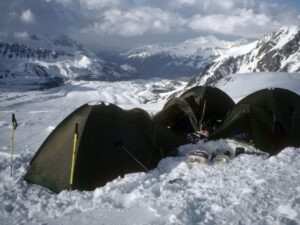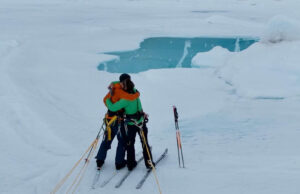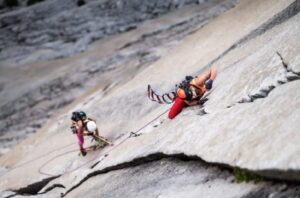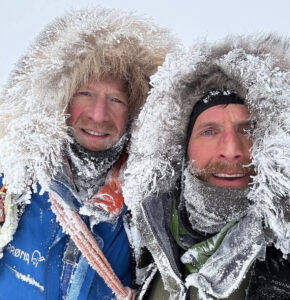Last week, TV personality Justin Fornal couldn’t boat through the ice to Canada to begin his swim back to Greenland. Instead, he did a much shorter swim off the Greenland coast. Below, an in-depth look at a well-publicized but failed adventure.
Justin Fornal is an eclectic action-hero who self-identifies as a “cultural detective”, “culinary anthropologist”, and a “blue-collar explorer”. A tireless storyteller and host of the Science Channel’s Unexplained and Unexplored, he loves magic and mysteries, or in his own words, “everything wild and weird”. He spends his life trying to go against the grain, or at the very least “trying to get behind some door and see what people are doing”.
I met Fornal in the late 2000s when he was still known as Baron Ambrosia, an extravagant addition to the Harlem cultural landscape. A frequent master of hazardous ceremonies at the Explorers Club in NYC, he introduced some very civil Upper East Side members and their guests to unorthodox beverages. These included secret ingredients such as castoreum, accompanied by raw game meat, undercooked insects, and smoked camel dung.
Some years ago, he fell in love with treacherous Greenlandic tupilaks, figures of avenging monsters traditionally made in secret from perishable materials. A few years later, he started to plan his 50km swim from Canada to Greenland across Smith Sound.
The Great Arctic Swim
Initially, Fornal was going to drag a barrel filled with indigenous tincture (an extract of plant or animal material dissolved in ethanol) to promote the drink and its producers across the globe, but his plans changed.
“I decided to say no to the big sponsors and travel to Greenland like people did for millennia, on a low budget,” said Fornal in our conversation a few weeks before his departure up north. “My goal is to bring attention to climate change and to give a voice to the indigenous people.”
As a true American, Fornal called his swim a Great Arctic Swim, a puzzle for local people whose culture is rooted in underestimation.

Photo: galyamorrell.com
Determined and inexhaustible, Fornal trained for the swim during the long COVID months. The closest landscape in NY to that part of Baffin Bay was the Hudson River. Fornal swam under the bridges, in the late winter ice, and I saw him crossing the Hudson in a gigantic carved-out 680kg pumpkin. The image went viral in NYC.
But the Hudson, no matter how big or great or icy, is not the High Arctic. When Fornal finally took off from White Plains, New York on August 7, he was still to discover this fact.

Hamming it up on the Hudson River. Photo: galyamorrell.com
Heading north
The original swim was meant to be in May. Fornal was planning to reach the ice edge by dogsled and then cross by boat to Canada. But the May swim was canceled because there was no open water.
In June, Fornal announced that he would fly from NY to Qaanaaq, Greenland in a small, one-engine Cirrus CR-22, piloted by his friend Wesley Archer.
“Once above latitude 63.7467°N, which is Iqaluit, there is no aviation fuel available for purchase. There are no gas stations…From that location we will carry fuel in the plane cabin to get to Qaanaaq,” Fornal wrote on his website.
But a week before departure, the plan changed again. Instead of Qaanaaq, Fornal and Archer flew to Kangerlussuaq, Greenland’s aviation hub. From there, they started north via Ilulissat and Upernavik.
On August 10, after traveling 4,500km and making seven stops in Canada and Greenland, Fornal and Archer reached Qaanaaq.
Smith Sound

Smith Sound: always ice and water. Photo: Jerry Kobalenko
Smith Sound, the location of Fornal’s swim, has been the port of historic migrations from Canada to Greenland for millennia.
Some 4,500 years ago, independent explorers routinely crossed from Greenland to Canada and back again. They moved without any particular mission, and without a compass, map, and resupplies. They carried all the belongings with them, hunting as they moved across the frozen unnamed vastness. Often, they traveled with their families, young children, and elders. Babies were sometimes born along the route. During the long polar nights, by the light of the full moon, they hunted walruses, seals, narwhals, and beluga in Pikialasorsuaq, known today as the North Water Polynya.
Ancient explorers most likely navigated by wind, snow, ice, and the stars. But also, their descendants say, with a little help from angaqqoqs, the flying shamans. These shamans led the way to their promised land: Greenland.
Today, even the most adventurous people are no longer independent. Today, to stay alive in those frozen waters, you need help, as did this Great Arctic Swim. That is why Jornal traveled with Inughuit guides. Hired to provide transportation, food, and lodging on the go; they are also tasked with chasing walruses, polar bears, and other potential intruders away from the swimmer.
Two great but understated guides
Two Inughuit hunters, referred to on the Great Arctic Swim’s website as simply “Inuit”, were hired to accompany Fornal. Their boats would take the expedition from Qaanaaq to Etah, then to Pim Island in Canada, back to Etah, and eventually to Qaanaaq.
Otto Simigaq, 61, comes from the distinguished family of the Simigaqs and is the adopted son of legendary polar bear hunter Kaugunak Kissuk. Otto was brought up in Siorapaluk, the northernmost settlement in the Thule District. As he grew up, he became one of the best hunters of his generation. He still hunts and fishes for halibut during the polar night.

Otto Simigaq. Photo: Bryan Alexander/Arcticphoto.com
Aaqqiunnguaq Qaerngaaq, the second guide, who owns a big boat, has spent many years in Moriussaq, where his wife Tukummeq was a teacher at the local school before the settlement was finally abandoned. Aaqqiunnguaq and Tukummeq, now deputy principal of the school in Qaanaaq, are a modern reincarnation of those legendary Inughuit couples of the past centuries, who ensured the success of the white explorers heading North.
The last migration
Simigaq and Qaerngaaq represent the proud Inughuit, formerly known as Polar Eskimos or Arctic Highlanders. Their life stories are deeply rooted in another crossing of Smith Sound, led by the legendary Qitdlarssuaq some 160 years earlier.
By the middle of the 19th century, the Inughuit had lost a large part of their traditional culture. Perhaps this happened simply because of too little driftwood: The only source of wood, it came sporadically from Siberian forests across the Arctic Ocean. They forgot how to make the qajaq and umiaq (sealskin boats) and they stopped using bows and arrows. As a result, in summer, they were confined to the land, where they could not hunt much. Even the caribou were out of reach.
The population was rapidly declining, and scientists were predicting their imminent extinction. The population at that time numbered no more than 140.
It took one great expedition to save the life and future of this nation.
Qitdlarssuaq
Qitdlarssuaq, also known as Qillarsuaq, or Qillaq, or “the great Qillaq”, led this expedition from Cumberland Sound via Pond Inlet. It lasted six years. Today it is known as “the last migration from Canada to Greenland.”
Qitdlarssuaq was reputed to be a great angaqqoq, a shaman, capable of flying above and under the sea ice, changing his shape to that of a polar bear or a seal, and seeing the future. According to other sources, Qitdlarssuaq learned about Greenland from a Greenlandic interpreter of Danish descent during his encounter with Captain Edward Inglefield, on Devon Island in 1853. Qitdlarssuaq might have used Captain Edward’s charts to define his final route to Greenland.
Once in Smith Sound, Qitdlarssuaq and his group crossed from Pim Island, off the Ellesmere Island coast, to Anoritoq, Greenland, an abandoned settlement whose name means “the windswept one”.
Near Etah, they met their first Inuk, named Arrutak. Arrutak had lost his leg and was now wandering around with a wooden leg that he had carved out of driftwood. Arrutaks’ appearance made members of Qitdlarssuaq’s expedition believe that they have arrived in a land of wooden-legged people.
With the arrival of Qitdlarssuaq, for the Inughuit a time of desperation had come to an end. Newcomers brought fresh blood and new/forgotten hunting and transportation technologies to ensure their survival.
The Inughuit were saved but Qitdlarssuaq was not. Qitdlarssuaq had fled from Canada to escape revenge for the murder of a fellow Uqqumiutaq. Once in Greenland, Qitdlarssuaq had to flee again, this time for murdering Avatannguaq, a powerful sorcerer in Avanersuaq. Qitdlarssuaq subsequently died on the way to Baffin Island.
For some, being first matters
Uusaqqak Qujaukitsoq, the Qaanaaq elder and a tireless champion of the interests and rights of Thule residents after their forced relocation from Thule to Qaanaaq, told me in 2012: “Foreigners come to Greenland for three reasons: murder, tax evasion, and love. Now there is a fourth one, fame. For us, it is hard to understand the value of this mission.”
With world maps fully drawn, explorers of all races and walks of life face a difficult prospect: what is left? One must be first in something to secure a spot in the Explorers’ Hall of Fame.
“Four years ago Justin [Fornal] and I [Wesley Archer] went caving in upstate New York with a mutual friend. What came out of that cave was the seed of an idea to do something special. A great adventure to the Arctic that included aviation, polar bears, Inuit hunters, and of course…The Swim,” the Great Arctic Swim website states.
Indeed, no one has ever swum in Smith Sound. I asked Inughuit elders why. They shrugged. “Why would it matter?”
But to be first matters in the rest of the world.
Justin Fornal was ranked third on the list of the Most Adventurous People in the World Right Now by Men’s Journal in 2018. “Later this year, he heads to Iraq to work with religious minorities; after that, he heads to Afghanistan to gather a rare rock from the oldest mine and deliver it to artists in New York. He’s also planning to swim 230 miles from Mopti to Timbuktu to build a clinic and raise awareness in the fight against female genital mutilation. ‘At the heart of all my field research is giving people a microphone,’ he says. ‘I want to get the stories out there while the stories can still be recorded,'” they wrote in his profile.

Qaanaaq in August: dragging a boat ashore on a slipway of iceberg pieces. Photo: galyamorrell.com
A truncated swim
About a week ago, on August 14, four days after his arrival in Qaanaaq, Fornal left for Etah, accompanied by his team. He was hoping for a calm sea to cross to Canada by boat and then swim back to Greenland.
Later that night, Simigaq and Qaerngaaq tried to cross the strait, but near midnight they stopped. There was too much thick ice.
They moved to Shelter Harbor and later made another attempt. By midday on August 15, the boats ran into more impassable ice. The forecast was not promising. At this time of the year, the brief arctic summer is waning quickly. Temperatures fall below freezing at night, making small ice floes grow together.
After a session of brainstorming, the team decided that Fornal would swim “from the point of maximum forward progress towards Canada. We will do the swim nature has allowed.”
According to the team, Fornal’s 18km swim lasted 7 hours and 30 minutes.
On Facebook, they wrote: “Justin Fornal completed the first non-stop swim from the middle of [Smith Sound] to Greenland. He in fact completed the first long-distance swim ever in [that region]. He touched down on Greenland’s shore at 7:30 pm Monday with great joy and happiness from our Inuit guides.”






